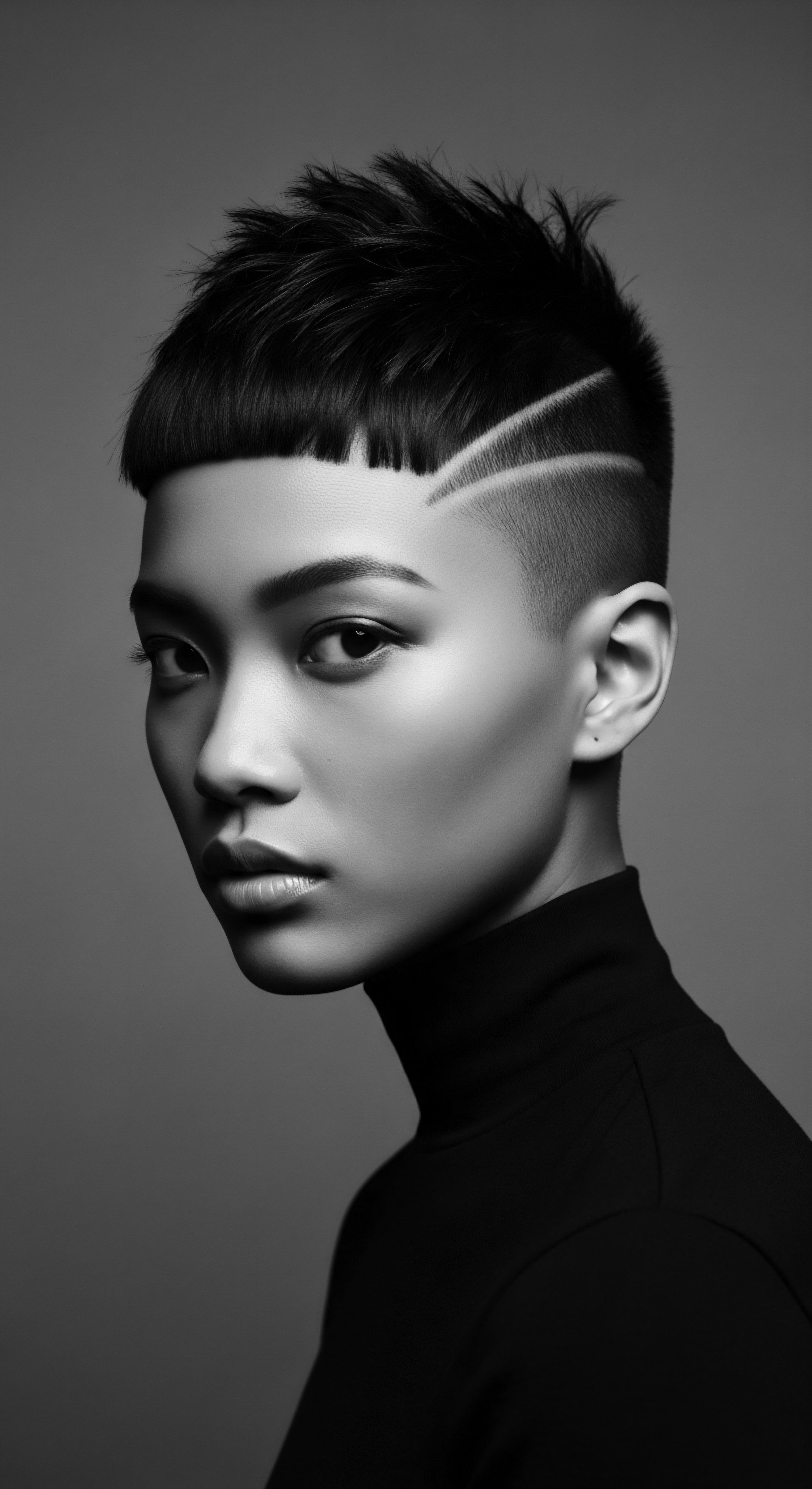
Fundamentals
The African Diaspora, at its simplest, represents the historical and ongoing global dispersion of people of African descent, largely stemming from the transatlantic trade of enslaved individuals. This profound movement scattered millions across the Americas, the Caribbean, and Europe, forging new communities while retaining deep, abiding connections to ancestral lands. For Roothea, this term holds a particular resonance, serving as a foundational understanding of how textured hair, specifically Black and mixed-race hair, carries the indelible marks of this collective journey. It is a concept that speaks to the very fiber of our being, a story etched in every curl, coil, and strand, connecting us across continents and centuries.
Ancestral communities, long before the forced migrations, understood hair not merely as a physical attribute but as a profound marker of identity, status, and spiritual connection. Hair was a living archive, communicating one’s lineage, marital status, age, and even tribal affiliation. The intricate patterns and deliberate care practices were interwoven with daily life, reflecting a deep reverence for the body and its connection to the cosmos.
This early understanding forms the bedrock of Roothea’s exploration, reminding us that the care and adornment of hair were never superficial acts, but rather sacred rituals passed down through generations. The very term “African Diaspora” thus becomes a lens through which we perceive the enduring spirit of these practices, even as they adapted to new environments and challenges.
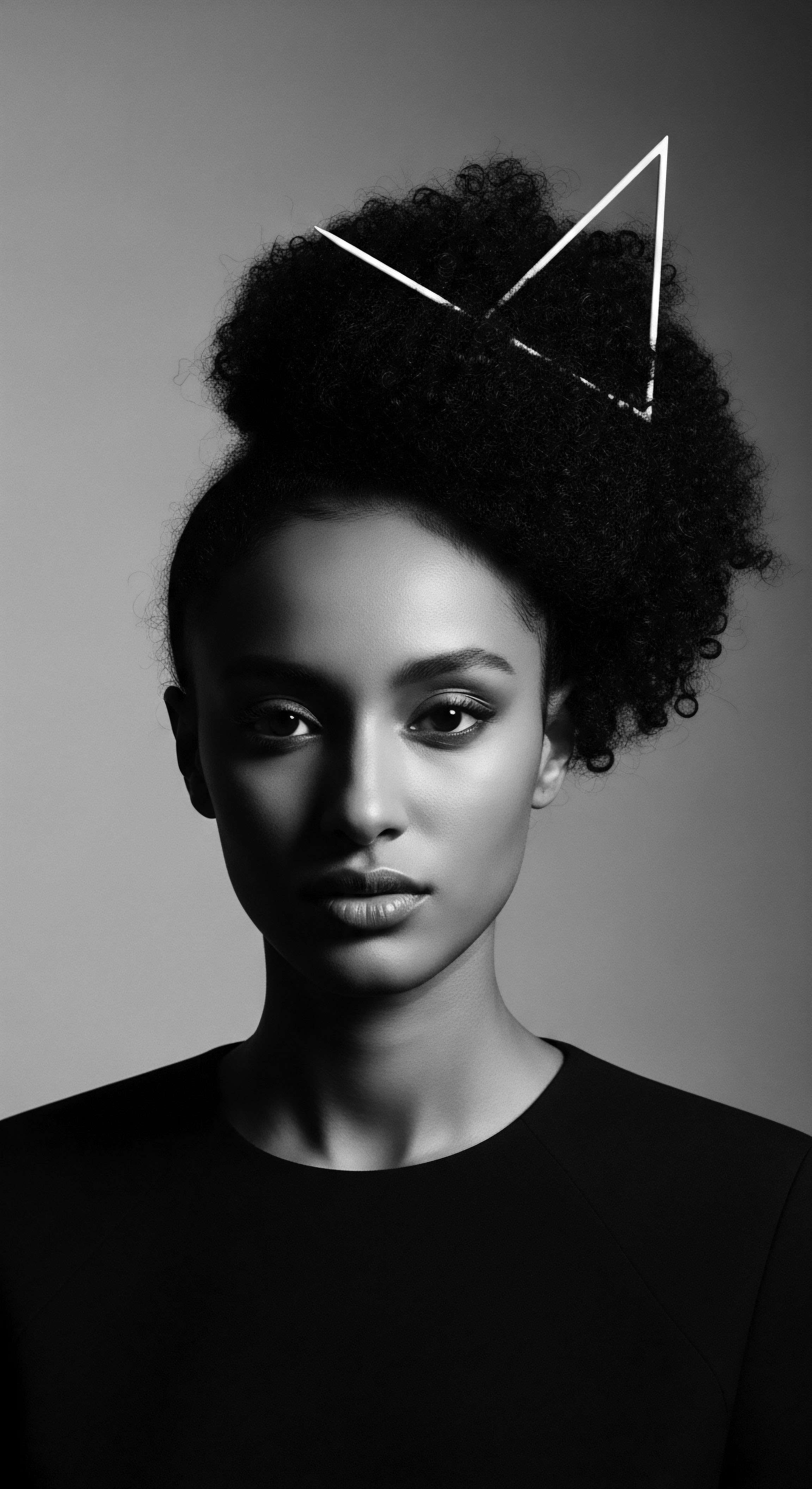
Echoes from the Source ❉ Pre-Colonial Hair Heritage
In the vibrant tapestry of pre-colonial Africa, hair styling transcended mere aesthetics, serving as a sophisticated visual language. Across diverse societies, a person’s coiffure could convey their position within the community, their family history, or even their spiritual beliefs. Archaeological evidence from ancient Egypt, the Kingdom of Kush, and various West African cultures reveals that African hairstyles were expressions of power, spirituality, and social cohesion. For instance, ancient Egyptians, both men and women of the elite class, wore elaborate wigs adorned with precious materials, symbolizing wealth and a connection to the divine.
The more intricate and decorated the style, the higher one’s social standing. In many West African societies of the 1400s, hairstyles communicated social status, marital status, wealth, age, and even a person’s surname. This rich heritage established hair as a central element of personal and communal identity.
The practices of hair care in these early societies were deeply communal. Braiding sessions, often lasting for hours, served as spaces for intergenerational bonding, storytelling, and the transmission of cultural knowledge. Mothers, sisters, and close friends would gather, their hands working rhythmically, sharing wisdom and reinforcing social ties. This communal aspect underscores the inherent social value of hair practices, positioning them not as solitary acts of grooming, but as shared rituals that strengthened community bonds and preserved cultural continuity.
The African Diaspora signifies a profound global journey, with textured hair serving as a living testament to enduring cultural heritage and resilience.
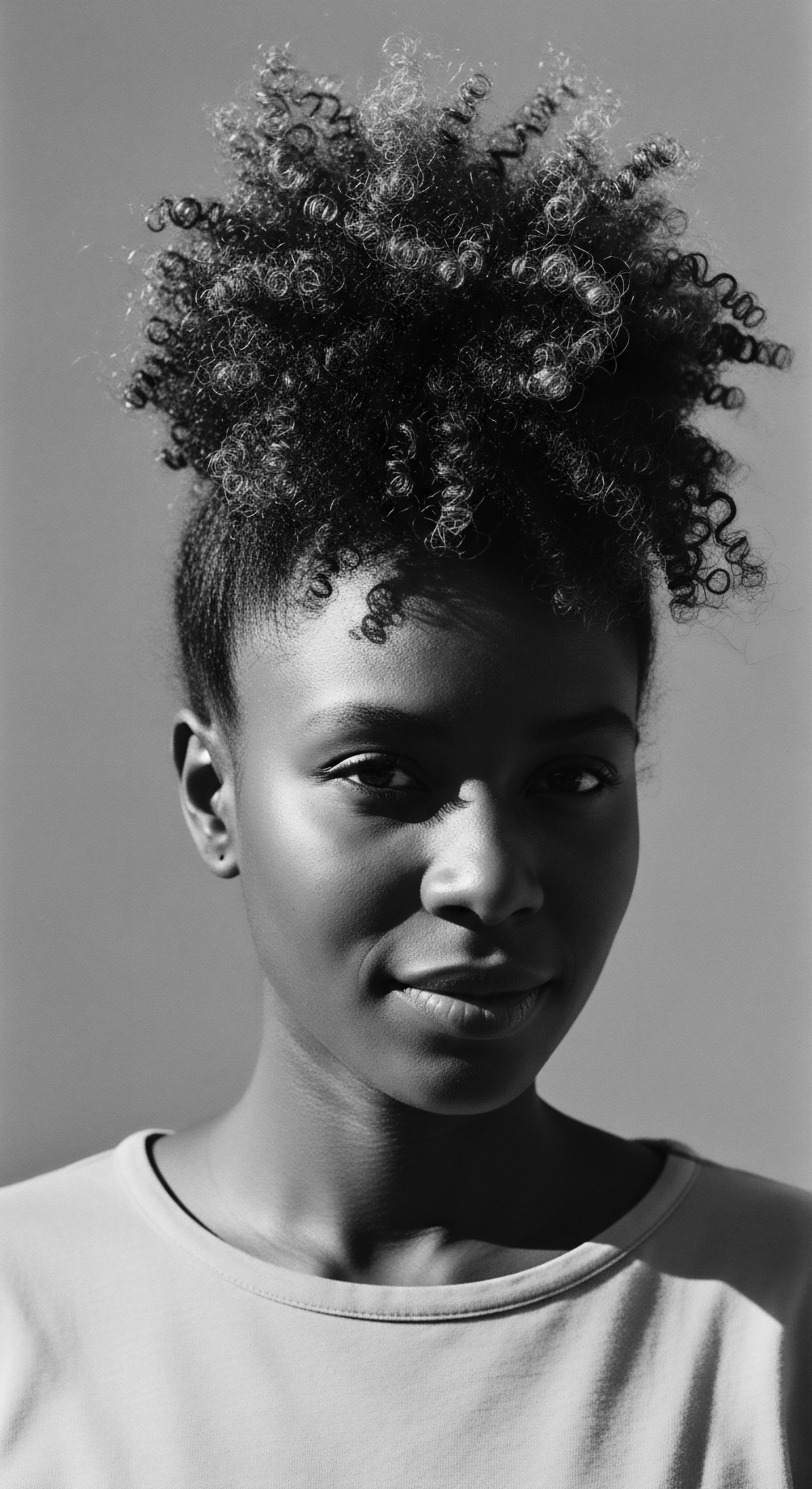
The Initial Severing ❉ Hair and Dispossession
The forced removal of Africans during the transatlantic trade brought an abrupt and brutal disruption to these established hair traditions. Upon arrival in the Americas, enslaved individuals were often subjected to head shaving, a deliberate act of dehumanization and an attempt to strip them of their identity and cultural markers. This violent act aimed to erase their connection to their homelands, tribes, and families, reducing them to mere commodities. Yet, even in the face of such profound cruelty, the spirit of hair heritage persisted.
Despite the lack of familiar tools and traditional ingredients, enslaved Africans found ways to maintain some hair practices. Headwraps, for instance, became prevalent, initially serving as a practical means to cover hair amidst harsh conditions and limited resources. Over time, these coverings evolved into symbols of resilience and identity, often crafted from vibrant fabrics, transforming an imposed necessity into a statement of defiance and cultural pride. This adaptation highlights the deep-seated significance of hair, even when its outward expression was constrained.
- Ancient Braiding ❉ Techniques like cornrows, dating back to 3500 BCE in Africa, served as a visual language conveying social status, age, and tribal affiliation.
- Communal Rituals ❉ Hair styling was a shared activity, strengthening community bonds and transmitting cultural knowledge across generations.
- Symbolic Adornment ❉ Hair was often adorned with beads, shells, and gold, reflecting wealth, spiritual beliefs, and personal narratives.
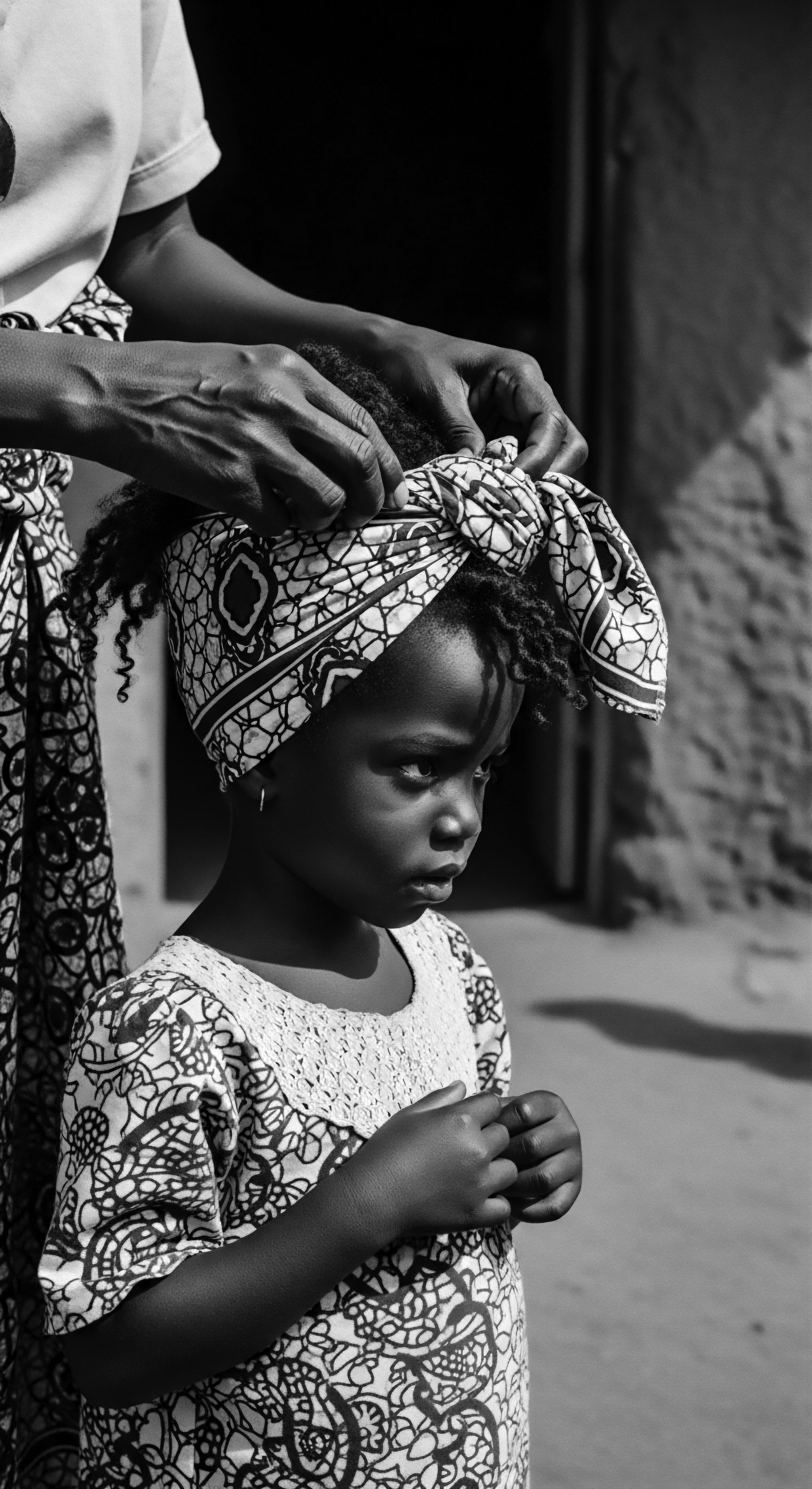
Intermediate
Moving beyond the foundational understanding, the intermediate meaning of the African Diaspora, within the context of textured hair, illuminates how heritage practices have been passed down, adapted, and reinterpreted across generations and geographies. This involves a deeper look at the resilience of traditional hair care rituals and styling practices, even as they encountered new environments and pressures. The continuity of these practices speaks to a profound cultural memory, a living lineage of wisdom that transcends the boundaries of time and place.

The Tender Thread ❉ Adaptation and Preservation of Hair Practices
Despite the immense challenges of enslavement and colonization, African hair traditions did not vanish. Instead, they underwent a remarkable process of adaptation and clandestine preservation. Enslaved individuals, stripped of many cultural expressions, held fast to hair practices as a silent yet potent assertion of their identity and humanity.
They utilized whatever natural resources were available, from local plant oils to animal fats, to care for their hair, often in secret gatherings that reinforced community bonds. These gatherings became crucial spaces for maintaining morale and cultural continuity.
The practice of braiding, for example, transformed into a covert form of communication. Cornrows, a style deeply rooted in African antiquity, were used to encode messages, including maps for escape routes from plantations. Some enslaved women, particularly rice farmers, even braided rice seeds into their hair, a means of preserving sustenance and cultural heritage for survival in new lands. This powerful historical example, often overlooked in broader narratives, underscores the ingenious ways hair became a tool of resistance and a repository of ancestral knowledge during the transatlantic slave trade.
(Walker, 2007, p. 45)
As communities of African descendants grew across the Caribbean, South America, and the United States, hair practices continued to evolve, influenced by the mixing of diverse African ethnic groups and the new landscapes they inhabited. The traditional communal nature of hair styling persisted, becoming an important way for families and communities to connect across generations, solidifying social bonds even in fragmented societies.
Diasporic hair practices represent a powerful continuity, transforming tools of oppression into symbols of cultural resistance and communal connection.

Shaping Identity ❉ Hair and Social Navigation
The post-slavery era brought new forms of pressure on textured hair. Eurocentric beauty standards, which favored straight hair, were imposed and internalized, leading to the pathologizing of coily and kinky textures. This preference for “straighter” hair often translated into economic opportunity and social advantage, creating a hierarchy within Black communities where lighter skin and straighter hair were often favored for less physically demanding labor or social mobility. This historical context is vital for understanding the complexities of Black hair experiences and the ongoing journey towards self-acceptance and pride.
In response, a burgeoning Black beauty industry emerged, pioneered by visionary Black women who understood the unique needs of textured hair and the societal pressures faced by their communities. Figures like Annie Turnbo Malone and Madam C.J. Walker developed specialized hair care products and systems that aimed to improve scalp health and allow for versatile styling, including methods for straightening hair without severe damage.
These entrepreneurs not only created products but also built economic empires, providing employment and training opportunities for thousands of Black women at a time when other avenues were largely closed off. Their work, born out of necessity and ingenuity, represents a significant chapter in the African Diaspora’s hair heritage, laying the groundwork for self-sufficiency and community building.
The early 20th century saw the proliferation of these Black-owned beauty businesses, creating spaces where Black women could access tailored products and receive care from stylists who understood their hair. These salons and beauty schools became more than just commercial establishments; they served as vital community hubs, places for sharing information, organizing, and fostering a sense of collective identity and empowerment.
| Historical Context Pre-colonial Africa (Echoes from the Source) |
| Traditional Ingredients & Practices Shea Butter (West Africa), Palm Oil (various regions), indigenous herbs, plant extracts, communal braiding rituals, hair sculpting with clay |
| Diasporic Adaptations & Modern Links Emphasized natural moisture, protection, and cultural symbolism; scientific understanding now affirms benefits of these traditional emollients for textured hair. |
| Historical Context Transatlantic Slave Trade & Early Diaspora (The Tender Thread) |
| Traditional Ingredients & Practices Limited access; reliance on available natural resources like animal fats, kerosene, butter; covert braiding for communication and seed preservation |
| Diasporic Adaptations & Modern Links Resourcefulness and resilience; these makeshift solutions highlight the desperate need for care and the persistence of styling despite deprivation. |
| Historical Context Post-Slavery & Early 20th Century (The Unbound Helix) |
| Traditional Ingredients & Practices Development of specialized products by Black entrepreneurs (e.g. hair growers, pressing oils); early chemical straighteners |
| Diasporic Adaptations & Modern Links A response to societal pressures and a quest for versatile styling; laid the foundation for the modern Black hair care industry, balancing health with aesthetic desires. |
| Historical Context The journey of hair care ingredients across the African Diaspora reveals a continuous story of adaptation, innovation, and unwavering dedication to nurturing textured hair, often validating ancestral wisdom through contemporary understanding. |

Academic
The African Diaspora, from an advanced academic perspective, constitutes a complex, transnational socio-historical phenomenon defined by the involuntary and voluntary migrations of African peoples and their descendants, profoundly shaping global cultural, social, and economic landscapes. Its specific meaning within the context of textured hair heritage is a multi-layered explication, encompassing biological anthropology, cultural semiotics, historical resistance movements, and the political economy of beauty. This meaning extends beyond mere geographical dispersion to signify a continuous, dynamic process of identity construction, cultural preservation, and contestation over aesthetic norms, all deeply inscribed upon the hair of Black and mixed-race individuals. The African Diaspora, in this scholarly lens, is a living testament to the human capacity for adaptation and enduring cultural memory, particularly as expressed through the biological specificities and cultural symbolisms of Afro-textured hair.

The Unbound Helix ❉ Biocultural Dimensions of Textured Hair
Understanding the African Diaspora’s relationship with textured hair necessitates an examination of its biocultural dimensions. Afro-textured hair, with its unique helical structure, high curl density, and elliptical cross-section, possesses distinct biological properties that necessitate specific care practices. This inherent biology, a legacy of evolutionary adaptation to diverse African climates, becomes a central point of reference when discussing the diaspora.
The historical movement of peoples meant these biological traits were carried to new environments, where they often faced mischaracterization and devaluation within Eurocentric aesthetic frameworks. The sociological value of hair, as a public, biological yet modifiable signifier, was particularly strong in pre-colonial African cultures, where hairstyles communicated ethnicity, clan, social status, and life events.
The academic delineation of the African Diaspora highlights how this biological reality became intertwined with social and political struggles. The systematic shaving of heads during the transatlantic passage was not merely a practical measure but a deliberate act of cultural obliteration, a symbolic stripping of identity and social standing that was deeply tied to the elaborate hair traditions of the homelands. This historical trauma created a lasting tension, where the natural state of textured hair was often stigmatized, leading to centuries of efforts to conform to imposed beauty ideals. Yet, within this adversity, an enduring legacy of ingenuity and self-preservation emerged, with hair serving as a site of both oppression and profound resistance.
The African Diaspora’s hair heritage is a dynamic interplay of biological uniqueness, cultural symbolism, and continuous adaptation in the face of historical challenges.
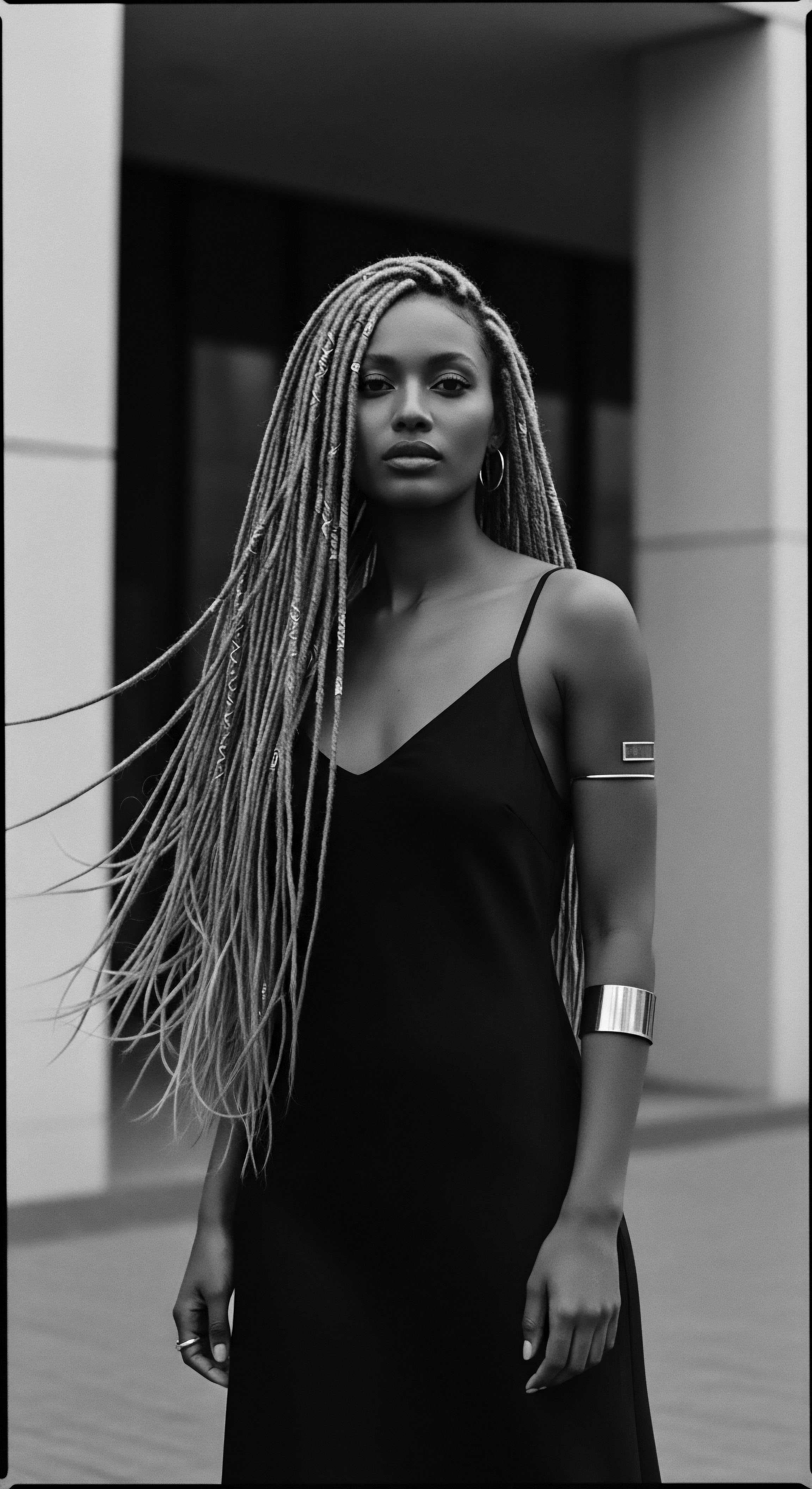
The Semiotics of Strands ❉ Hair as Cultural Archive and Resistance
From an academic perspective, hair within the African Diaspora functions as a powerful semiotic system, a language that communicates group identity and historical narratives. The continuity of hair grooming practices and African aesthetics throughout the diaspora is anthropologically significant because of the socio-cultural role hair continues to play among Black communities. Sybille Rosado’s work (2003) posits that “among women of African descent, hair and hairstyles are evidence of a set of rituals that are being practiced throughout the diaspora” (Rosado, 2003, p.
61). This scholarly lens allows us to dissect the morphology and syntax of these hair symbols, understanding how they have been used to communicate between members of the African Diaspora and sustain the transfer of cultural knowledges and practices across generations.
A poignant example of this semiotic function is the Tignon Law enacted in Louisiana in 1786. This legislation forced free Black and biracial women to cover their hair with a headwrap, or “tignon,” ostensibly to rein in their social climbing and mark their inferior status to white women. However, these women subverted the oppressive intent by transforming the mandated headwraps into elaborate, colorful, and adorned statements of style and defiance, reclaiming agency and asserting their identity through creative expression. This historical instance provides a compelling case study of how cultural practices, even under duress, become sites of resistance and reinterpretation within the African Diaspora, demonstrating hair’s role as a canvas for rebellion and identity assertion.
The modern-day CROWN Act (Creating a Respectful and Open World for Natural Hair) in the United States and similar legislative efforts across various states and municipalities are direct descendants of this historical struggle. These laws prohibit discrimination based on hair texture and protective hairstyles (such as locs, cornrows, twists, and braids), acknowledging that such discrimination is a form of racial bias inextricably tied to Black identity and heritage. This contemporary legal framework underscores the enduring impact of historical prejudices and the ongoing societal work required to validate and celebrate textured hair within the African Diaspora.

The Political Economy of Beauty ❉ Entrepreneurship and Self-Definition
The African Diaspora’s hair heritage is also deeply intertwined with the political economy of beauty. The exclusion of Black women from mainstream beauty markets in the late 19th and early 20th centuries spurred the creation of a robust, self-sufficient industry. Pioneering entrepreneurs like Annie Turnbo Malone, who developed “Wonderful Hair Grower” and established the Poro College Company in 1902, and her mentee, Madam C.J. Walker, built vast empires providing products and training tailored to textured hair.
Malone’s Poro College, for example, became the nation’s first Black-owned cosmetology school, offering instruction in Black hair and skin care and providing a foundation for women to establish their own beauty businesses. This was not merely about commerce; it was a profound act of self-determination, creating economic opportunities and fostering community resilience in a segregated society.
The growth of this industry, which saw Black women entrepreneurs as the fastest-growing segment in the U.S. since 2014 with a 164% increase (State of Black Women in Business study, 2022), stands as a direct lineage to Malone’s and Walker’s foundational work. Their legacy demonstrates how the African Diaspora, through its collective needs and innovative spirit, created a parallel economy that not only addressed practical hair care challenges but also served as a powerful vehicle for social mobility, empowerment, and the re-definition of beauty standards from an Afrocentric perspective. The ongoing success of Black-owned beauty brands today continues this tradition, rooted in an ancestral wisdom that recognizes hair as a sacred part of self and heritage.
The academic discourse on the African Diaspora, therefore, is incomplete without a rigorous examination of its hair heritage. It reveals how hair has served as a dynamic medium for expressing identity, resisting oppression, transmitting cultural knowledge, and forging economic pathways. This holistic understanding allows for a deeper appreciation of the African Diaspora as a living, breathing cultural force, continuously shaping and being shaped by the intricate stories held within its textured strands.
- Biological Adaptations ❉ Afro-textured hair’s unique structure, a result of evolutionary processes, necessitates specific care approaches, a foundational element in diasporic hair science.
- Cultural Semiotics ❉ Hairstyles and care practices within the diaspora serve as a complex system of communication, conveying social status, history, and collective identity.
- Economic Empowerment ❉ The historical development of a Black-owned beauty industry provided vital economic independence and challenged dominant beauty norms, reflecting a deep cultural self-reliance.
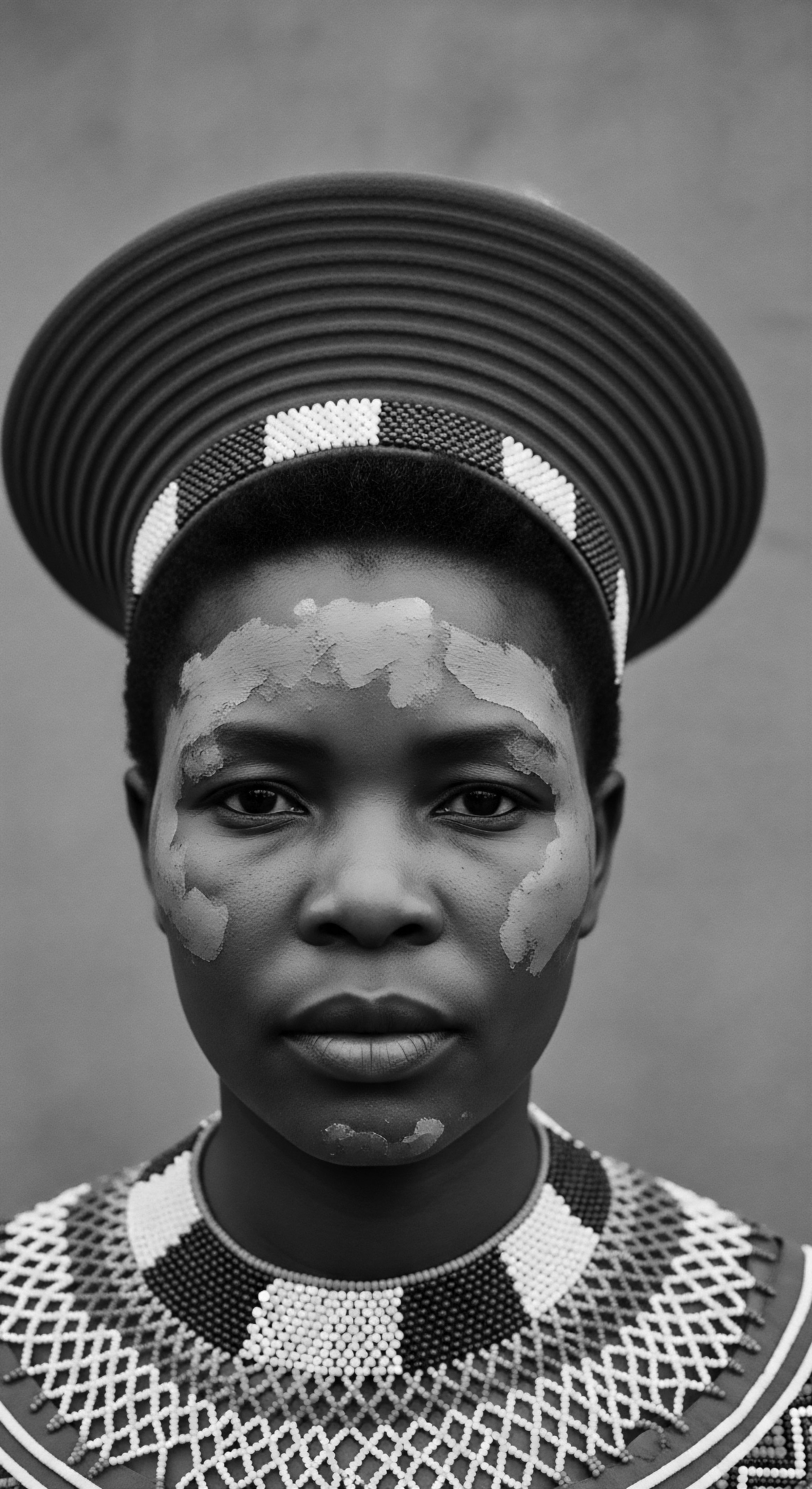
Reflection on the Heritage of African Diaspora
The journey through the African Diaspora, viewed through the lens of textured hair, is a profound meditation on resilience, memory, and the enduring power of cultural lineage. It reminds us that hair is never merely a collection of strands; it is a living, breathing archive, holding stories of triumphs, sorrows, and unwavering spirit. From the ancestral hearths where intricate braids signified belonging and wisdom, to the forced passages where hair became a silent language of resistance, and onward to contemporary expressions of pride and self-determination, the heritage of textured hair within the diaspora stands as a powerful testament to human tenacity.
The Soul of a Strand ethos, therefore, is not a nostalgic gaze into the past, but a vibrant acknowledgment of a continuous, living heritage. It recognizes that every curl, every coil, carries the echoes of ancient practices, the tender care passed down through generations, and the boundless potential for future self-definition. Our hair is a tangible connection to those who came before, a reminder of the wisdom they cultivated in nurturing these unique textures, and the battles they waged for the right to wear them authentically. To care for textured hair is to honor this rich ancestry, to participate in a timeless ritual that bridges continents and centuries, affirming beauty, identity, and belonging.
This living library of Roothea celebrates the scientific wonders of textured hair’s biology, the historical narratives woven into its styles, and the holistic wellness that comes from embracing its inherent beauty. It invites us to approach our hair with reverence, understanding that in its very structure lies a deep connection to a global family, a shared history, and a collective future where every strand tells a story of enduring heritage.

References
- Afriklens. (2024). African Hairstyles ❉ Cultural Significance and Legacy. Retrieved from https://www.afriklens.com/african-hairstyles-cultural-significance-and-legacy/
- African American Museum of Iowa. (n.d.). History of Hair. Retrieved from https://blackiowa.org/exhibits/history-of-hair/
- BLAM UK CIC. (2022). The history of Black Hair. Retrieved from https://blamcharity.org/the-history-of-black-hair/
- Buala. (2024). Hair as Freedom. Retrieved from https://www.buala.org/en/face-a-face/hair-as-freedom
- Creative Support. (n.d.). The History of Black Hair. Retrieved from https://www.creativesupport.co.uk/the-history-of-black-hair/
- Gale Review. (2021). African Hairstyles – The “Dreaded” Colonial Legacy. Retrieved from https://www.galereview.com/african-hairstyles-the-dreaded-colonial-legacy/
- HBCU Leggings. (2024). Black History Month Spotlight ❉ Pioneers in Black Hair Care. Retrieved from https://hbculeggings.com/blogs/news/black-history-month-spotlight-pioneers-in-black-hair-care
- History.com Editors. (2009). Madam C. J. Walker – Products, Hair & Facts. Retrieved from https://www.history.com/topics/black-history/madam-c-j-walker
- JSTOR Daily. (2019). How Natural Black Hair at Work Became a Civil Rights Issue. Retrieved from https://daily.jstor.org/how-natural-black-hair-at-work-became-a-civil-rights-issue/
- Khumbula. (2024). A Crowning Glory ❉ Hair as History, Identity, and Ritual. Retrieved from https://khumbula.org/a-crowning-glory-hair-as-history-identity-and-ritual/
- Legal Defense Fund. (n.d.). Hair Discrimination FAQ. Retrieved from https://www.naacpldf.org/hair-discrimination-faq/
- Life and Legacy of Annie Malone – Peoria Riverfront Museum. (n.d.). Retrieved from https://www.peoriariverfrontmuseum.com/exhibits/life-and-legacy-of-annie-malone
- Library of Congress. (n.d.). Heavy is the Head ❉ Evolution of African Hair in America from the 17th c. to the 20th c. Retrieved from https://www.loc.gov/static/programs/teachers/classroom-materials/presentations-and-activities/presentations/hair/Heavy-is-the-Head-Evolution-of-African-Hair-in-America-from-the-17th-c.-to-the-20th-c. pdf
- McGill Journal of Law and Health. (2022). Afro-Hair and the Law ❉ The State of American and Canadian Law on Race-Based Hair Discrimination. Retrieved from https://mjlh.mcgill.ca/article/afro-hair-and-the-law-the-state-of-american-and-canadian-law-on-race-based-hair-discrimination/
- Odele Beauty. (2021). 6 Things Everyone Should Know About Black Hair History. Retrieved from https://odelebeauty.com/blogs/journal/black-hair-history
- Odele Beauty. (2024). A History Lesson On Hair Braiding. Retrieved from https://odelebeauty.com/blogs/journal/history-of-hair-braiding
- Oxford Research Encyclopedia of American History. (2017). Black Women and Beauty Culture in 20th-Century America. Retrieved from https://oxfordre.com/americanhistory/view/10.1093/acrefore/9780199329175.001.0001/acrefore-9780199329175-e-440
- ResearchGate. (n.d.). Hair in African Art and Culture. Retrieved from https://www.researchgate.net/publication/237256679_Hair_in_African_Art_and_Culture
- Scholar Commons. (n.d.). Examining Afrocentricity and Identity Through the Reemergence and Expression of Natural Hair. Retrieved from https://scholarcommons.sc.edu/etd/6356/
- SHSMO Historic Missourians. (n.d.). Annie Turnbo Malone. Retrieved from https://historicmissourians.shsmo.org/annie-turnbo-malone/
- Tangled Roots ❉ Decoding the history of Black Hair | CBC Radio. (2021). Retrieved from https://www.cbc.ca/radio/ideas/tangled-roots-decoding-the-history-of-black-hair-1.5888806
- The History and Cultural Significance of African Hair Braiding. (2023). Retrieved from https://elomafricanbraids.com/the-history-and-cultural-significance-of-african-hair-braiding/
- The History and Symbolism of Hair Wrapping Across the African Diaspora. (2025). Retrieved from https://aripartyhair.com/blogs/hair-culture/the-history-and-symbolism-of-hair-wrapping-across-the-african-diaspora
- The Legacy of Black Hair Care Historic Moments and Contributions. (2025). Retrieved from https://curliehair.com/blogs/news/the-legacy-of-black-hair-care-historic-moments-and-contributions
- The Untold Legacy of Annie Turnbo Malone ❉ Uncovering a Hidden Entrepreneurial Journey. (2025). Retrieved from https://www.forbes.com/sites/forbeswomensforum/2025/02/02/the-untold-legacy-of-annie-turnbo-malone-uncovering-a-hidden-entrepreneurial-journey/
- University of Salford Students’ Union. (2024). The Remarkable History Behind Black Hairstyles. Retrieved from https://www.salford.ac.uk/students/student-life/student-voice/black-history-month-remarkable-history-behind-black-hairstyles
- Vertex AI Search. (2023). What Every Dermatologist Must Know About the History of Black Hair. Retrieved from https://vertexaisearch.cloud.google.com/grounding-api-redirect/AbF9wXEGYa1r_6wqwk_Tpk-kBeuBT9DOSD72YJFmMCykcdZRwPMNhpDHN6-4LXNZHqgOmq2_7dR4bgZB7JYA2xT3snUlh18P11ezS0u6hyXct_VMYIEmdUiSQI1rXYgAIvpc6UfHYsVltfUdJSUlryxCYP2THQqipMqap6d5c-SJqqMSURSnCm2BS27XUte-aPsh6ijEmRGSoF3X2HycaJHal3rwRnVX3AUE-HtF7Xn-bS31M6I6
- Walker, A. (2007). On beauty and being natural ❉ A historical study of Black women’s hair. Oxford University Press.
- WhiteLotusHairStudio. (n.d.). Black Hair History. Retrieved from https://www.whitelotushair.com/black-hair-history/
- Wikipedia. (n.d.). Discrimination based on hair texture in the United States. Retrieved from https://en.wikipedia.org/wiki/Discrimination_based_on_hair_texture_in_the_United_States
- YorkSpace. (2021). Braided Archives ❉ Black hair as a site of diasporic transindividuation. Retrieved from https://yorkspace.library.yorku.ca/xmlui/handle/10315/38477
